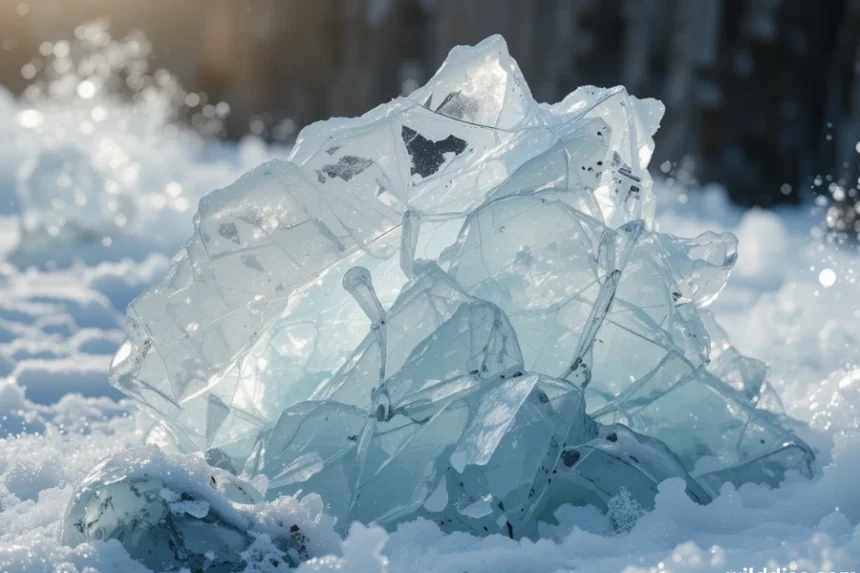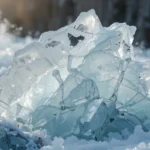Introduction to Transparent Ice
Transparent ice is a remarkable natural phenomenon that captivates scientists and nature enthusiasts alike. Unlike typical ice, which often appears cloudy or opaque, transparent ice boasts exceptional clarity and smoothness, allowing us to see through it as if it were glass. This unique form of ice is not only admired for its aesthetic appeal but also holds significance in various scientific and environmental contexts. Understanding how transparent ice forms, its properties, and its applications offers valuable insights into the dynamics of freezing water and the beauty of natural processes.
How Does Transparent Ice Form?
The formation of transparent ice is a complex process influenced by multiple environmental and physical factors. Unlike regular ice, which contains trapped air bubbles and impurities that scatter light, transparent ice develops in conditions that minimize these inclusions. The key factors involved include:
Pure Water Quality: The purity of water plays a crucial role. Water free from dust, minerals, and other impurities is more likely to freeze into transparent ice.
Slow Freezing Rate: Slow freezing allows impurities and air bubbles to escape before the water solidifies completely, leading to clearer ice.
Controlled Environment: Temperature stability and reduced vibrations during freezing help produce a uniform crystal structure, enhancing transparency.
Direction of Freezing: Progressive freezing from one direction (often top to bottom) can push out impurities, resulting in clearer ice layers.
Mixing these factors in a controlled environment, such as laboratory settings or specialized ice-making processes, results in the creation of remarkable transparent ice.
Natural Occurrences of Transparent Ice
While many associate transparent ice with artificial conditions, it also occurs naturally under specific circumstances:
Frozen Lakes and Ponds: During cold seasons, lakes and ponds sometimes develop clear ice layers if the water is pure and freezing occurs gradually.
Ice Caves: Some ice caves contain naturally formed transparent ice stalactites and stalagmites that have developed over centuries.
Glacial Ice: Certain glaciers exhibit regions of highly transparent ice, especially in areas with minimal air exposure and contamination.
In these natural settings, the formation of transparent ice is a slow process influenced by environmental factors such as temperature, water purity, and the surrounding ecosystem.
Properties and Characteristics of Transparent Ice
Transparent ice exhibits distinct physical properties that set it apart from typical ice:
Clarity and Transparency: The most prominent feature, allowing visibility through the ice, akin to glass.
Crystal Structure: Composed of hexagonal ice crystals arranged uniformly, which contributes to its clarity.
Strength and Durability: Despite its delicate appearance, transparent ice can be quite strong, especially when thick and well-formed.
Thermal Conductivity: Its ability to conduct heat varies depending on purity and crystal structure.
Aesthetic Appeal: Its natural beauty makes it desirable for artistic and decorative purposes.
These properties make transparent ice not just scientifically interesting but also visually stunning.
Applications of Transparent Ice
The unique qualities of transparent ice have led to various applications across different fields:
Art and Sculpture: Artists often use transparent ice to craft sculptures and installations that play with light and perception.
Scientific Research: Researchers study transparent ice to understand glacial movements, climate change, and cryogenics.
Tourism and Experience: Transparent ice formations in caves and glaciers attract tourists and adventurers worldwide.
Ice Hotels and Resorts: Some luxury accommodations use transparent ice for design elements, creating mesmerizing environments.
Environmental Monitoring: Studying naturally occurring transparent ice helps scientists monitor environmental conditions and water quality.
As a versatile material, transparent ice continues to inspire innovation and artistic expression.
Challenges in Producing Transparent Ice
Despite its allure, producing pure transparent ice outside natural conditions presents certain challenges:
Contamination: Even tiny impurities can disrupt crystallization, resulting in cloudy or opaque ice.
Control of Freezing Conditions: Maintaining a consistent freezing rate and environment can be technically demanding.
Storage and Handling: Once formed, transparent ice is susceptible to melting or cracking if not stored properly.
Cost and Equipment: Creating high-quality transparent ice requires specialized tools and controlled settings, making it expensive.
Overcoming these challenges involves scientific techniques, such as filtration, slow freezing, and environmental control, to achieve the desired clarity.
The Future of Transparent Ice
Advancements in technology and environmental understanding are paving the way for new possibilities with transparent ice. Researchers are exploring innovative methods to produce larger and clearer ice structures for artistic, scientific, and commercial purposes. Additionally, understanding the natural formation of transparent ice offers insights into climate dynamics, as changes in ice quality and distribution can indicate shifts in environmental conditions.
As our appreciation for natural and artificial transparent ice grows, so does the potential for its application in sustainable design, climate research, and art. With ongoing innovation, transparent ice is poised to remain a fascinating subject of study and admiration for years to come.
Conclusion
Transparent ice is a mesmerizing natural and artificial phenomenon rooted in the intricate balance of environmental factors and physical processes. Its clarity, strength, and aesthetic appeal make it a subject of scientific interest and artistic creativity. Whether forming slowly in a glacier or crafted in a laboratory, transparent ice exemplifies nature’s beauty and the wonders of the frozen world. Exploring its formation, properties, and potential applications not only enhances our understanding of ice but also deepens our appreciation for the delicate, transparent beauty that can emerge from water when conditions are just right.



